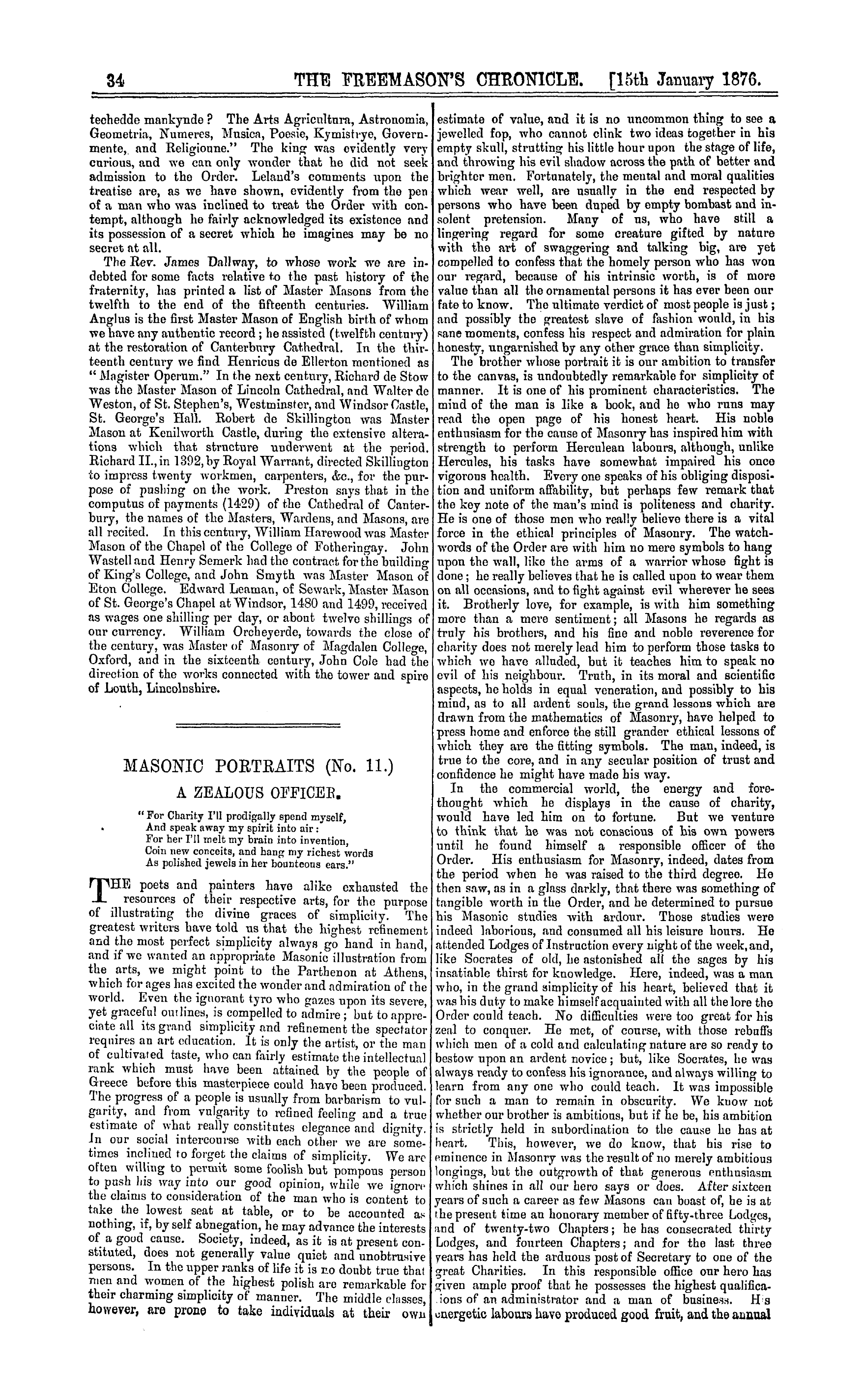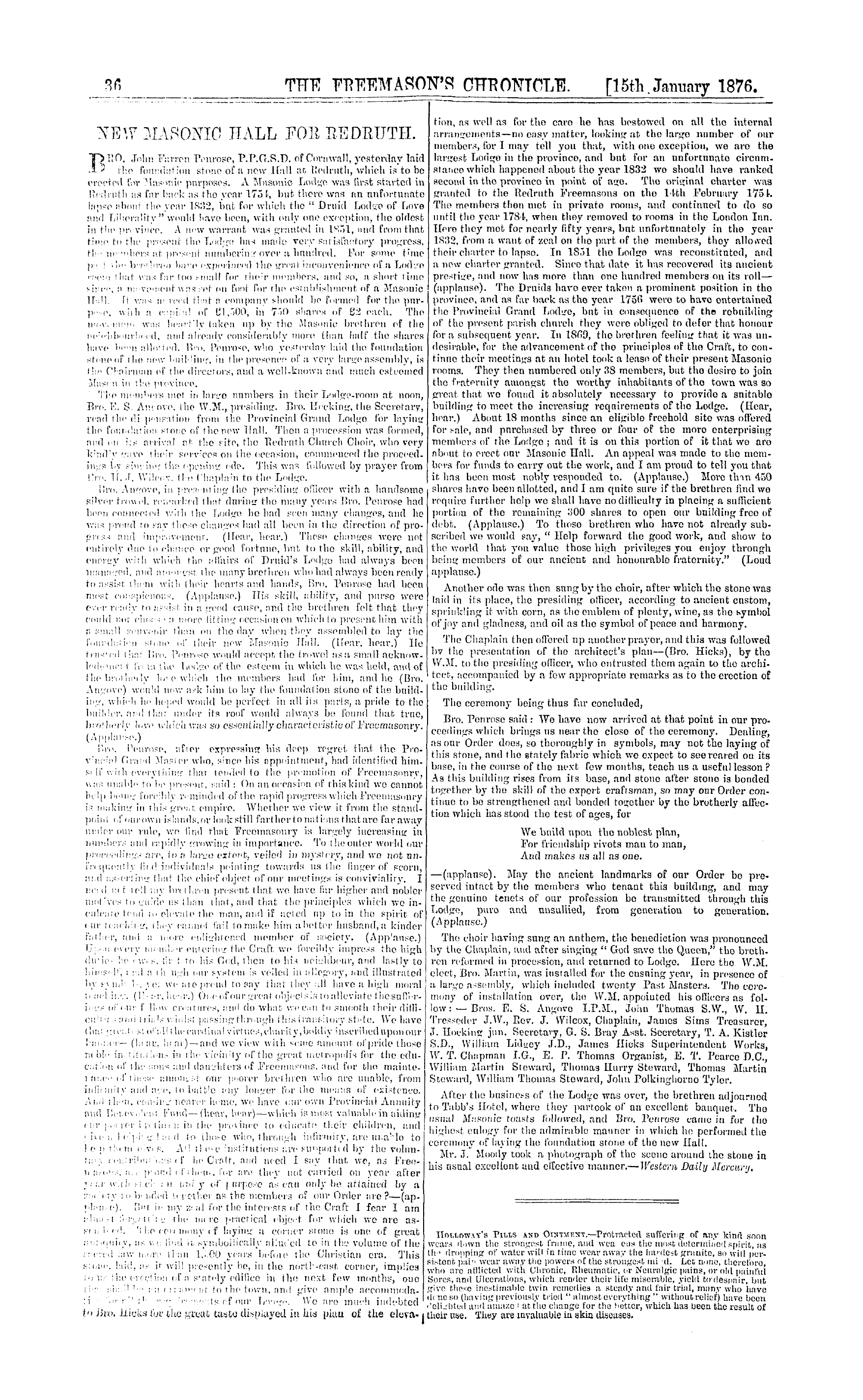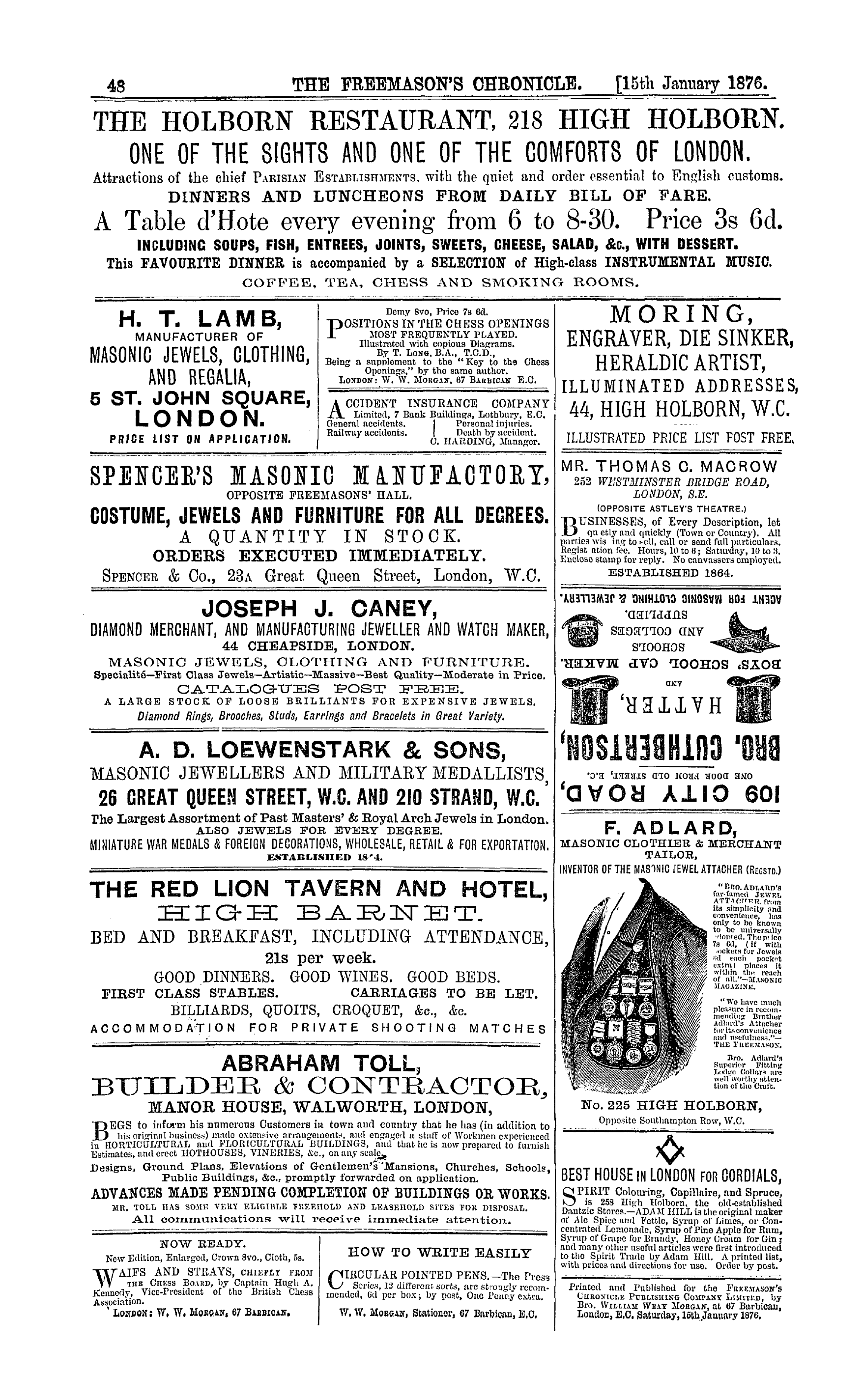-
Articles/Ads
Article THE ANTIQUITY OF FREEMASONRY. Page 1 of 2 Article THE ANTIQUITY OF FREEMASONRY. Page 1 of 2 →
Note: This text has been automatically extracted via Optical Character Recognition (OCR) software.
The Antiquity Of Freemasonry.
THE ANTIQUITY OF FREEMASONRY .
IT has been asserted by the enemies of Masonry that the vaunted antiquity of the fraternity is a mere myth , which rests upon no solid basis of fact , and that Masonic appeals to history are but the efforts of the literary acrobat who jumps backwards into the past and fashions for himself the links with wbich he unites his isolated
facts . Possibly the logic of some of the Masonic historians who have written upon the past career of the Order is open to this charge . We have ourselves noticed much loose writing and much vague assertion and surmise in some important Masonic works . But our critics , who are onlv too
ready to discredit the antiquity of the Order , should remember the difficulties which surround the history of any secret society . Masonic history is undoubtedly involved in much obscurity , yet unquestioned proofs exis ^ that the Craft , as a secret fraternity , existed in very early times .
The Master Mason is a personage who figures in ancient historical documents , and it is quite certain that he was the chief of a band of subordinates , who held many secrets of the Craft in common . Gibbon tells us , in his history , that previously to the founding of Constantinople , "the
magistrates of tho most distant provinces were directed , by a royal edict , to institute schools , to appoint professors , and , by the hopes of rewards and privilege , to engage in the study and practice of architecture a sufficient number of ingenious youths who had received a liberal education . "
A similar mandate was issued b y the Emperor Theodosius . In the eight century , Charlemagne had invited artificers from every country of Europe in wbich they were established , to erect his church at Aix-la-Chapelle . It is therefore certain that bands of artisans so early as the eighth
century were scattered over the Continent . After the Norman Conquest , Lanfrance and Gundulph brought over bodies of Masons to this country from the Continent . They had previously been employed in building the churches at Caen , and that attached to the celebrated
Abbey of Bee . Gnndnlph himself appears to have been versed in Masonry , and the designs for some of the castles of the period are attributed to him . "William , of Sens , appears to be the first Master Mason whoso works still exist in England . He was assisted , and succeeded by
William , the Englishman , in the completion of the Choir of Canterbury Cathedral . At the commencement of the thirteenth century the fraternit y appears to have been consolidated in this country , as it had been for some years previously in Germany and France . The German school is
held by some authorities to have had priority over the French . There was , it appears , a college of Masons at Strasbourg , and another at Cologne , and the Masters of these were allowed a jurisdiction over all inferior societies , wherever they exercised their craft . In these colleges
regulations were passed , which were preserved under the strong sanction of good faith and secrecy . These colleges were probably very numerously attended by Master Masons ; all instruction , it is said , was delivered orally . It is asserted that the Colleges of Masons , in every country in Europe
received in this century tlie blessing of tho Holy Scej under an injunction of dedicating their skill to the erection of ecclesiastical buildings , and that certain immunities were conceded them , such as forming themselves info
migratory societies , under the government of a Master of the Craft , with the privilege of taking apprentices , who , after a due initiation , became FREE AND ACCEPTED MASONS . This statement , however , has not been verified . Still it
The Antiquity Of Freemasonry.
cannot be doubted that Masons were at this time banded together in societies , and that tho secrets or mysteries of the Craft were jealously preserved from tho prying eyes of the vnlger . Many eminent ecclesiastics of
the period are mentioned as the des gners or builders of Churches and Cathedrals . No doubt , men like William W y keham possessed some knowledge of architecture , but it is at least doubtful if the priests ever did more than
suggest the rough ideas of buildings , while the details were supplied by the skilled craftsmen . Wykeham , indeed , appears to have been a skilled Mason , but many
prelates whose names are associated with tho building of cathedrals were , probably , mere patrons , who found the cash , and took to themselves the honour which should have been bestowed upon the Master Mason .
In the earliest era of the Masonic establishments , a geometrical figure was adooted in all sacred buildings , the import of which was hidden from the vulgar . It had possibly some Christian signification , but it had likewise a
Masonic meaning which was perfectly understood by the fraternity . This symbol was formed by two circles cutting each other in their centres ; it was held in high veneration , and was adopted by Master Masons in all countries . It
was evidently symbolical of the principles which underlie the construction of the pointed arch . Tlie brotherhood in this country were frequently employed on military works , and in the making of engines of war . Tlie splendid castles
of the fourteenth and fifteenth centuries were the work of Master Masons and their subordinates ; the names of some of the former have been handed down to ns . There is little or no trace of the Freemasons as a fraternity from the
fourteenth century , until too reign of Henry VI . ; a MS ., which is said to have been signed by this Icing , makes some curious references to the secrets of the Craft . The
original , unfortunately , is not in existence , but a copy was taken by Leland , and preserved by him in the Bodleian Library . This has been recopied , and was first published at Frankfort , in 1748 . This singular treatise is
entitled—( Ccrtsmu Questions toytlj ^ usbcrcs tlie sumc , ronccminrje tlie mnstcrjT of JtJiuonriic , foriitcnnc bn the hunt ) of ihirc 1 ] ntriie the sinrtije of the ir . intc , nub f ; utbfu ! lii co'imco bn me loliim ^ enlaubc , § artiqiuuius , bn . caiunuitbc of his IVtah
iressc * From the treatise and the acute comments of L'daa upon it , it is clearly established ihat , at this period ( I !¦ - ! ¦ ">) the Masons possessed certain secrets . Leland , indeed ,
declares that such secrets the Masons must have , ' ¦ f ' oi though , as some people imagine , they have no secret at : •, even that must be a secret which , being discovered , w .. ¦ expose them to the highest ridicule , and , then-fore , it
inquires the utmost caution to conceal it . " The irony ot ' this passage is sufficient proof that Leland was not at the time , when he wrote it , in any way connected with the fraternity , although it has been asserted that he was
afterwards admitted a brother . The king ' s treatise commences with the question , '' What mote it ( die secret ) lie ?" Answer : " Yt beith the sky lit ; of nature ; the iniderstandynge of the nivghte that ys herynne , and its snndrve
werkynges , suiiderlyche , the skill of reckonn yuges ; of wayghtes aud metynges ; and the true maneie o ( Faconynge all things for mannys use , lieadlio , dwellings and buildynges of al . kindes , and ; . !! oi ! : \ er f ' : v ¦ : < :: •;' , make goode te manne . What arte- luv . ' c * Kiua Homy Viil .
Note: This text has been automatically extracted via Optical Character Recognition (OCR) software.
The Antiquity Of Freemasonry.
THE ANTIQUITY OF FREEMASONRY .
IT has been asserted by the enemies of Masonry that the vaunted antiquity of the fraternity is a mere myth , which rests upon no solid basis of fact , and that Masonic appeals to history are but the efforts of the literary acrobat who jumps backwards into the past and fashions for himself the links with wbich he unites his isolated
facts . Possibly the logic of some of the Masonic historians who have written upon the past career of the Order is open to this charge . We have ourselves noticed much loose writing and much vague assertion and surmise in some important Masonic works . But our critics , who are onlv too
ready to discredit the antiquity of the Order , should remember the difficulties which surround the history of any secret society . Masonic history is undoubtedly involved in much obscurity , yet unquestioned proofs exis ^ that the Craft , as a secret fraternity , existed in very early times .
The Master Mason is a personage who figures in ancient historical documents , and it is quite certain that he was the chief of a band of subordinates , who held many secrets of the Craft in common . Gibbon tells us , in his history , that previously to the founding of Constantinople , "the
magistrates of tho most distant provinces were directed , by a royal edict , to institute schools , to appoint professors , and , by the hopes of rewards and privilege , to engage in the study and practice of architecture a sufficient number of ingenious youths who had received a liberal education . "
A similar mandate was issued b y the Emperor Theodosius . In the eight century , Charlemagne had invited artificers from every country of Europe in wbich they were established , to erect his church at Aix-la-Chapelle . It is therefore certain that bands of artisans so early as the eighth
century were scattered over the Continent . After the Norman Conquest , Lanfrance and Gundulph brought over bodies of Masons to this country from the Continent . They had previously been employed in building the churches at Caen , and that attached to the celebrated
Abbey of Bee . Gnndnlph himself appears to have been versed in Masonry , and the designs for some of the castles of the period are attributed to him . "William , of Sens , appears to be the first Master Mason whoso works still exist in England . He was assisted , and succeeded by
William , the Englishman , in the completion of the Choir of Canterbury Cathedral . At the commencement of the thirteenth century the fraternit y appears to have been consolidated in this country , as it had been for some years previously in Germany and France . The German school is
held by some authorities to have had priority over the French . There was , it appears , a college of Masons at Strasbourg , and another at Cologne , and the Masters of these were allowed a jurisdiction over all inferior societies , wherever they exercised their craft . In these colleges
regulations were passed , which were preserved under the strong sanction of good faith and secrecy . These colleges were probably very numerously attended by Master Masons ; all instruction , it is said , was delivered orally . It is asserted that the Colleges of Masons , in every country in Europe
received in this century tlie blessing of tho Holy Scej under an injunction of dedicating their skill to the erection of ecclesiastical buildings , and that certain immunities were conceded them , such as forming themselves info
migratory societies , under the government of a Master of the Craft , with the privilege of taking apprentices , who , after a due initiation , became FREE AND ACCEPTED MASONS . This statement , however , has not been verified . Still it
The Antiquity Of Freemasonry.
cannot be doubted that Masons were at this time banded together in societies , and that tho secrets or mysteries of the Craft were jealously preserved from tho prying eyes of the vnlger . Many eminent ecclesiastics of
the period are mentioned as the des gners or builders of Churches and Cathedrals . No doubt , men like William W y keham possessed some knowledge of architecture , but it is at least doubtful if the priests ever did more than
suggest the rough ideas of buildings , while the details were supplied by the skilled craftsmen . Wykeham , indeed , appears to have been a skilled Mason , but many
prelates whose names are associated with tho building of cathedrals were , probably , mere patrons , who found the cash , and took to themselves the honour which should have been bestowed upon the Master Mason .
In the earliest era of the Masonic establishments , a geometrical figure was adooted in all sacred buildings , the import of which was hidden from the vulgar . It had possibly some Christian signification , but it had likewise a
Masonic meaning which was perfectly understood by the fraternity . This symbol was formed by two circles cutting each other in their centres ; it was held in high veneration , and was adopted by Master Masons in all countries . It
was evidently symbolical of the principles which underlie the construction of the pointed arch . Tlie brotherhood in this country were frequently employed on military works , and in the making of engines of war . Tlie splendid castles
of the fourteenth and fifteenth centuries were the work of Master Masons and their subordinates ; the names of some of the former have been handed down to ns . There is little or no trace of the Freemasons as a fraternity from the
fourteenth century , until too reign of Henry VI . ; a MS ., which is said to have been signed by this Icing , makes some curious references to the secrets of the Craft . The
original , unfortunately , is not in existence , but a copy was taken by Leland , and preserved by him in the Bodleian Library . This has been recopied , and was first published at Frankfort , in 1748 . This singular treatise is
entitled—( Ccrtsmu Questions toytlj ^ usbcrcs tlie sumc , ronccminrje tlie mnstcrjT of JtJiuonriic , foriitcnnc bn the hunt ) of ihirc 1 ] ntriie the sinrtije of the ir . intc , nub f ; utbfu ! lii co'imco bn me loliim ^ enlaubc , § artiqiuuius , bn . caiunuitbc of his IVtah
iressc * From the treatise and the acute comments of L'daa upon it , it is clearly established ihat , at this period ( I !¦ - ! ¦ ">) the Masons possessed certain secrets . Leland , indeed ,
declares that such secrets the Masons must have , ' ¦ f ' oi though , as some people imagine , they have no secret at : •, even that must be a secret which , being discovered , w .. ¦ expose them to the highest ridicule , and , then-fore , it
inquires the utmost caution to conceal it . " The irony ot ' this passage is sufficient proof that Leland was not at the time , when he wrote it , in any way connected with the fraternity , although it has been asserted that he was
afterwards admitted a brother . The king ' s treatise commences with the question , '' What mote it ( die secret ) lie ?" Answer : " Yt beith the sky lit ; of nature ; the iniderstandynge of the nivghte that ys herynne , and its snndrve
werkynges , suiiderlyche , the skill of reckonn yuges ; of wayghtes aud metynges ; and the true maneie o ( Faconynge all things for mannys use , lieadlio , dwellings and buildynges of al . kindes , and ; . !! oi ! : \ er f ' : v ¦ : < :: •;' , make goode te manne . What arte- luv . ' c * Kiua Homy Viil .















